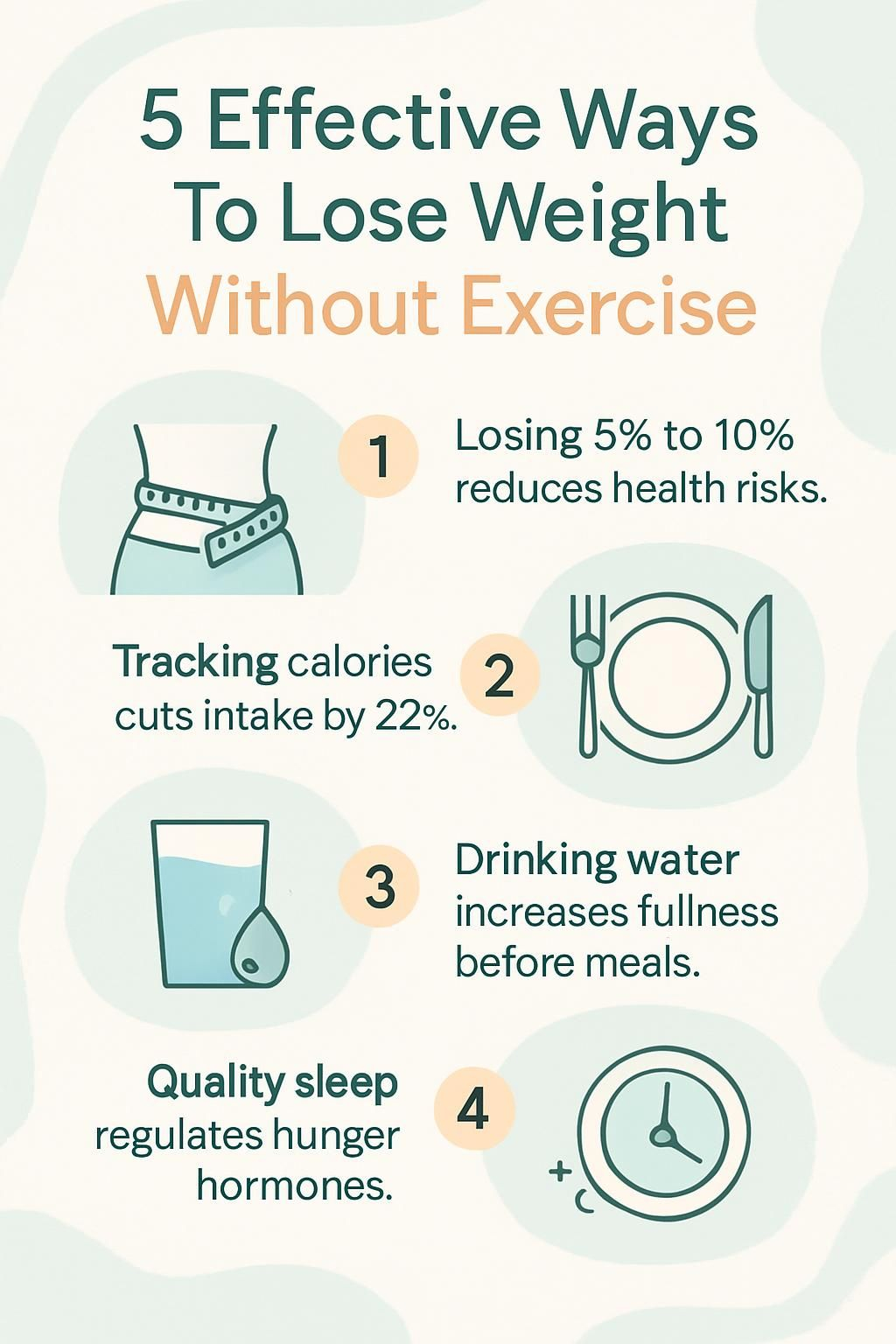5 Effective Ways To Lose Weight Without Exercise
Our Nutrition Assistant AI Suite will transform your body. You will lose fat, get toned, and build muscle. Gain confidence and optimal health.
Want to lose weight without exercise or long gym sessions? Adjusting how you eat often drives the biggest change. Many dietitians, including clinical dietitian Jessica Tilton, note that food choices shape results more than most people think.
This guide shares practical ways to create a calorie deficit through smarter habits. You will learn about portion size, hydration, protein, sleep, and simple meal timing. Use these tips to lose weight safely at a steady pace.
Key Takeaways
- Losing 5 to 10 percent of your body weight at 1 to 2 pounds per week lowers risk for type 2 diabetes and heart disease, according to the CDC.
- Tracking calories, using smaller plates, and choosing high-protein foods can reduce intake by up to 22 percent and increase fullness, based on Cornell University and a 2015 Journal of Nutrition study.
- Drink about 11.5 cups for women and 15.5 cups for men daily. Having one pint of water before meals helps you eat fewer calories.
- At least 7 hours of sleep supports healthy hunger hormones. High stress can drive cravings for high-calorie foods, reports from the CDC and JAMA Internal Medicine show.
- Intermittent fasting, such as 16:8, and mindful eating may improve weight loss by organizing when you eat and supporting better choices.

Understanding Your Weight Loss Needs

Clear goals start with a clear picture of your current health. A little prep now makes your plan safer and easier to follow.
How do I assess my current weight and health?
Begin with simple checks to learn where you stand. These steps help you set safe targets.
- Calculate your Body Mass Index, or BMI. A BMI of 25 or higher is considered overweight for adults in obesity research.
- Measure your waist just above your hip bones. Over 40 inches for men or 35 inches for women signals higher risk for heart disease and type 2 diabetes.
- Review lab results like blood sugar, cholesterol, and blood pressure. These markers link to cardiovascular disease and metabolic dysfunction-associated steatotic liver disease.
- Note your eating patterns, energy, sleep, and mood. High-sugar diets often pair with low energy or digestive trouble.
- Talk with a registered dietitian or your primary care doctor. As Jessica Tilton, RD, explains, professional input keeps goals safe and screens for hidden issues.
- Consider family history of obesity, hypertension, breast cancer, or heart problems. Genetics can affect fat storage and weight change.
- Look at past attempts. Using a food app once helped me notice liquid calories from sweetened drinks, which cut mindless snacking.
These checks give you a solid baseline. Use the results to set goals that match health standards from the Academy of Nutrition and Dietetics.
What should my weight loss goals be?
After your assessment, aim to lose 5 to 10 percent of your current weight. For someone at 180 pounds, that means 9 to 18 pounds. Research shows this range improves blood pressure, blood sugar, and cholesterol. The CDC advises losing about 1 to 2 pounds per week.
To reach that pace, create a daily calorie deficit of roughly 500 to 750 calories. Focus on fat loss, not just the scale. Tracking calories, eating more fiber, and cutting added sugar help many people stick with it.
Choose changes you can live with long term. If you have a medical condition or take medication, get guidance from a qualified health professional.
What factors affect weight loss?
Age, sex, and metabolism shape how quickly you lose weight. As people age, they often burn fewer calories at rest. Women usually have a higher body fat percentage than men, so calorie targets can differ.
Genes can affect how your body stores fat and responds to calorie restriction. Hormones matter too. Leptin and ghrelin help control fullness and hunger. Stress raises cortisol, which can spark cravings for high-calorie foods. Thyroid issues and other conditions can also slow progress, notes the American Heart Association.
Tracking added sugar from soft drinks made a real difference for me. Next, learn how to set a daily calorie goal you can manage.
Monitor Your Calorie Intake
Knowing how many calories you burn each day helps you decide what to eat and drink. Think of it as a simple dashboard for your weight loss plan.
How do I calculate my daily calorie needs?
Start with an estimate, then adjust based on results. Small, steady changes beat extreme cuts.
- Use a Total Daily Energy Expenditure, or TDEE, calculator. Enter your age, sex, height, weight, and activity level.
- Estimate Resting Energy Expenditure with the Mifflin-St Jeor or Harris-Benedict formula. This is the energy you use at rest.
- Create a deficit of 300 to 500 calories from your TDEE for steady loss, as the CDC recommends.
- Avoid going below 1,200 calories for most women or 1,500 for most men unless supervised by a clinician.
- If you eat a plant-based, gluten-free, or vegetarian diet, double-check protein, iron, calcium, and vitamin B12.
- Track meals and drinks with an app or food diary. Choose water instead of sugar-sweetened beverages to cut liquid calories.
- Recalculate your TDEE every few weeks. Less body weight means lower calorie needs.
- After I switched to oats and brown rice, I lost about one kilogram every two weeks.
These steps help you set a smart calorie target without a strict workout plan.
How can I track my food portions effectively?
Portion awareness helps you eat fewer calories without feeling deprived. Make measuring simple and repeatable.
- Use smaller plates or bowls. Research suggests plate size can change how much you serve by up to 30 percent.
- Weigh foods with a digital kitchen scale, especially rice, pasta, and bread.
- Measure foods like olive oil, dairy, beans, almonds, seeds, and lentils with cups and spoons.
- Compare food label serving sizes to what you actually eat.
- Cook at home more often. Restaurant and packaged foods hide extra calories.
- Pre-portion snacks like apple slices, carrot sticks, or walnuts to avoid grazing.
- Use a quick photo journal for meals and snacks. Visual records build accountability.
- Skip second helpings unless you feel true physical hunger.
- Pause halfway through your meal to check fullness. Fast eaters often miss satiety signals and may gain weight over time.
- Do not eat from large packages. Put chips or nuts on a plate first.
These habits build portion control skills you can rely on, even without daily calorie math.
How can I avoid mindless snacking?
Unplanned snacking can sneak in many extra calories. Use simple cues to slow the habit.
- Eat at the table, not in front of a screen. Distraction dulls fullness cues.
- Pause before you snack. Ask if you are hungry or just bored, stressed, or thirsty. Drink water first.
- Pick high-fiber snacks like pears, popcorn, or chickpeas instead of chips or cookies.
- Prep healthy choices ahead, such as cucumber sticks, roasted salmon bites, or orange slices with lime.
- Portion snacks into small containers to avoid overeating.
- Chew slowly during meals and snacks. A 2020 review linked mindful eating with better weight control in adults with obesity.
- Keep soda, candy, and pastries out of reach. Stock the fridge with yogurt, edamame, and citrus-infused water.
- Logging every snack for two weeks cut my intake. The act of tracking changed my choices.
- Set kitchen closing hours to reduce late-night eating during long periods of sitting.
- Focus on taste. Enjoy each bite so a smaller portion feels satisfying.
Focus on Healthy Eating Habits
Small upgrades add up, like swapping refined grains for whole grains. Each choice helps your next one.
Why should I eat more fiber-rich foods?
Fiber helps you feel full longer, so eating less becomes easier. The daily target is about 28 grams for most women and 34 grams for most men.
Choose foods rich in viscous fiber, which slows stomach emptying. Good picks include black beans, oatmeal, Brussels sprouts, oranges, asparagus, flaxseed, berries, vegetables, legumes, and whole grains like oats and brown rice.
Hitting your fiber target can reduce snacking between meals. On days I add black beans to lunch, the afternoon feels easier to control.
Low glycemic index choices may steady blood sugar and support a calmer mood. Focus on whole foods that bring vitamins, minerals, and steady energy.
How can I add more protein to my meals?
Protein increases fullness and helps protect muscle during weight loss. Many adults do well with up to 1.6 grams of protein per kilogram of body weight.
Simple swaps work. Try eggs and whole grain toast for breakfast, Greek yogurt for a snack, or salmon, chicken breast, tofu, quinoa, or lentils at meals. I replaced sugary treats with a small handful of almonds, which cut cravings.
Higher-protein diets can increase thermogenesis, the small rise in calorie burn after eating. Pair protein with vegetables and whole grains for balanced meals.
What processed and sugary foods should I avoid?
Cut back on added sugars and heavily processed items. Soda, sweet teas, candy, pastries, and sugary cereals add calories fast but do little for fullness.
Limit chips, packaged cookies, fast food, and refined grains like white bread. These choices can spike cravings and make it harder to stay on track.
Be careful with liquid calories from alcohol and sweetened drinks. One can of soda often has about 150 calories and over 30 grams of sugar. I swapped my daily soda for water with lime and saw steady progress.
Next, see how hydration supports appetite control.
How much water should I drink to stay hydrated?
For most adults, aim for about 15.5 cups, or 3.7 liters, for men and 11.5 cups, or 2.7 liters, for women. These totals include water from food and beverages.
Drinking a pint, about 568 milliliters, before meals led people to eat fewer calories in a 2015 study. A 2018 study saw similar results.
Keeping a water habit can improve choices at meals. A tall glass before lunch helped me feel satisfied with a smaller portion.
Mindful hydration pairs well with mindful eating, which you will learn next.
Practice Mindful Eating
Slow, focused meals act like a volume knob for hunger signals. Turn the noise down and you will eat just enough.
How can chewing food thoroughly help weight loss?
Eating slowly gives your brain time to notice fullness. Studies find that slow eaters tend to have lower BMI than fast eaters.
Try counting chews before swallowing or set your fork down between bites. Many people feel satisfied with less food when they slow their pace.
This simple habit helps cut calories without strict rules. It also reduces snacking that comes from eating on autopilot.
Why use smaller plates to control portions?
Smaller plates make portions look larger, which can help you feel content with less. A 2021 review linked smaller dishes with lower weight, BMI, waist size, and improved blood lipids.
Some studies estimate about a 22 percent drop in calories when people use smaller plates instead of large ones. It is an easy change you can use at every meal.
Once plate size feels natural, limit distractions to get even better control.
How do I avoid distractions while eating?
Focused meals improve awareness of hunger and fullness. A 2022 review found that distracted eating delays satiety and raises intake.
- Turn off the TV and silence your phone before meals.
- Eat at a table. This setting supports portion awareness.
- Keep devices away while you eat to avoid mindless bites.
- Chew thoroughly and slow down. Give fullness time to show up.
- Notice flavors, colors, and textures to increase satisfaction.
- Set regular mealtimes to reduce stress eating.
These habits make each meal more intentional, which supports steady weight loss.
Improve Your Lifestyle Choices
Better sleep, less stress, and fewer sugary drinks work together like gears in a clock. Align them and progress feels smoother.
How does quality sleep impact weight loss?
Sleep affects hunger hormones. Less than 7 hours can lower leptin, the fullness signal, and raise ghrelin, the hunger signal.
Low leptin makes it tough to feel satisfied. High ghrelin can push you toward calorie-dense snacks. The CDC recommends at least 7 hours of sleep per night for most adults.
Poor sleep may increase the risk of losing muscle instead of fat during a calorie deficit. Solid rest stabilizes appetite and supports better choices the next day.
What are effective ways to manage stress?
Stress can nudge eating out of balance. Use short daily practices to calm your system.
- Take five minutes of deep breathing. Slow exhales help lower cortisol.
- Try mindfulness meditation. Research in JAMA Internal Medicine links it to less stress and steadier eating.
- Keep a journal to spot triggers that lead to snacking.
- Call a friend or family member when you feel overwhelmed.
- Use calming activities like music, reading, or a short outdoor walk.
- Limit caffeine and sugary drinks during high-stress periods.
- Keep steady routines for meals and bedtime to reduce random cravings.
People who reduce stress often find it easier to follow a healthy diet because cravings quiet down.
Why should I limit sugary drinks?
Cutting sugary drinks is one of the fastest ways to reduce calories. These beverages raise risk for weight gain, type 2 diabetes, and heart disease.
A 2022 review found that replacing sugary drinks with low or no-calorie options reduced body weight and body fat. Liquid calories do not fill you up, so they are easy to overconsume.
Try water, sparkling water with lime, unsweetened tea, or vegetable juice. Replacing even one sweet drink a day can produce steady change.
Explore Intermittent Fasting
Meal timing is another lever you can use. Choose a schedule that fits your life so it is easy to keep.
What is time-restricted eating?
Time-restricted eating, or TRE, means eating all meals within a set daily window, such as 10 a.m. to 6 p.m. You are not changing what you eat as much as when you eat.
Consistent timing may reduce total calories and curb late-night snacking. A 2017 study linked regular meal schedules with lower obesity risk.
When I tried TRE, evening cravings faded after two weeks. Planning the window also simplified grocery choices.
How do I choose the right fasting schedule?
Pick a plan you can sustain. Safety and consistency matter more than trends.
- Review your daily routine and typical meal times first.
- Talk with a healthcare professional if you have conditions like diabetes or heart disease.
- Start with 12:12, twelve hours eating and twelve hours fasting, to ease in.
- Move to 16:8 if it fits your schedule, eight hours eating and sixteen hours fasting.
- Consider alternate-day fasting only after you build experience with TRE.
- Adjust based on hunger and energy. Your body gives useful feedback.
- Use trusted resources from Mayo Clinic or Johns Hopkins for guidance.
- Track results with a food diary or app. That helped me adopt 16:8.
Pair fasting with portion control and balanced meals for the best results.
Benefits of Losing Weight Without Exercise
Food choices can drive big health gains. Even modest weight loss can shift how you feel day to day.
What are the benefits of sustainable weight loss?
Steady progress helps you keep weight off long term. Losing 5 to 10 percent of your weight lowers the risk of diabetes, heart disease, and high blood pressure.
Stable habits beat fast swings on the scale. Confidence grows as energy rises and your routine gets easier to follow.
Lasting changes like mindful eating and portion control build a strong base. You are less likely to rely on quick fixes or fad diets.
How does losing weight improve health and energy?
Losing weight can improve blood sugar, cholesterol, and blood pressure. Even a modest drop, 5 to 10 percent, makes a difference.
Less weight reduces joint strain and whole-body inflammation, which can ease aches and improve comfort. Many people notice better focus and mood once sleep and eating patterns improve.
After I lost ten pounds through diet changes, workdays felt less tiring. Small wins add up to a more active and enjoyable day.
These gains show why diet and lifestyle matter so much for long-term success.
Why focus on diet and lifestyle habits?
Calories in and out decide weight change. Managing your diet is the most direct way to create a calorie deficit.
Tracking meals for a month helped me spot patterns that slowed progress. Simple shifts, like more vegetables and fewer sugary drinks, moved the needle.
Consistent sleep, stress control, and smart beverage choices add momentum. Together, these habits support steady weight management.
Frequently Asked Questions
Here are quick answers to common questions about losing weight without exercise.
Can I lose weight quickly without exercise?
Rapid weight loss without exercise is risky. The CDC recommends a pace of 1 to 2 pounds per week, which usually requires a 500 to 600 calorie daily deficit.
Pushing for 20 pounds in a month can cause muscle loss, nutrient gaps, and a slower metabolism. Aim for steady changes you can maintain. Balanced meals and portion control offer safer results with better long-term health.
What are easy tips to reduce calorie intake?
Small changes can cut many calories with little effort. Try a few at a time.
- Use smaller plates to make portions look larger. Cornell research suggests up to a 22 percent drop in intake.
- Drink water before meals. Studies in Obesity show people eat less when they do this.
- Fill half your plate with vegetables or beans. Volume helps control hunger.
- Include protein like eggs, chicken breast, or Greek yogurt at each meal. A 2015 Journal of Nutrition study links protein to higher satiety.
- Limit processed snacks, refined grains, sweets, and fast food.
- Pre-portion snacks into small bowls to avoid overeating.
- Eat slowly and chew well. Slow eaters often consume fewer calories.
- Replace soda and juice with water or unsweetened tea to cut liquid calories.
- Plan meals ahead to avoid last-minute takeout.
- Keep healthy snacks visible and stash candy out of sight.
- Track intake with a notebook or app to spot patterns and adjust.
How can I stay motivated during weight loss?
Motivation changes over time. Build systems that keep you going on tough days.
- Set a clear goal, like losing 5 percent of your weight.
- Track progress weekly with a journal or app.
- Write your personal reasons for change and read them daily.
- Celebrate small wins, like skipping a sugary drink.
- Ask friends for support or join an online group.
- Notice non-scale wins such as better sleep or more energy.
- Picture how steady progress improves your daily life.
- Place reminders where you will see them, like the fridge or desk.
- Expect setbacks and restart quickly. One rough day does not erase your work.
I kept a simple note on my fridge with my reasons. Seeing it each morning helped me stick with the plan during busy weeks.
Conclusion
Losing weight without exercise is achievable with steady habit changes. Focus on mindful eating, portion size, and a daily calorie deficit. Drink enough water, especially before meals, to help you feel full.
Build meals around protein, vegetables, fruits, and whole grains like oats and brown rice. Limit sugary drinks to cut liquid calories. Protect your sleep, since better rest supports better choices.
These steps make weight loss safer and more sustainable. This article is for general education. If you have a medical condition or take medication, seek advice from your healthcare professional or a registered dietitian for a plan that fits your needs.
FAQs
1. What are five effective ways to lose weight without exercise?
You can lose weight by eating smaller portions, choosing foods high in fiber, drinking more water, getting enough sleep, and reducing added sugars in your diet. These methods help control calorie intake and support healthy metabolism. Studies show that people who follow these habits often see steady progress in weight loss.
2. How does drinking more water help with weight loss?
Drinking water before meals helps you feel full faster and may lead to eating fewer calories. Research from the Journal of Clinical Endocrinology & Metabolism found that drinking 500 milliliters of water increased metabolic rate by about 30 percent for over an hour.
3. Can sleep affect my ability to lose weight without exercise?
Yes, sleep plays a key role in weight control. Poor sleep disrupts hormones that manage hunger and fullness, leading to increased appetite and cravings for unhealthy foods. A study in the Annals of Internal Medicine showed that people who slept less lost less fat compared to those who got enough rest.
4. Is cutting added sugar important for losing weight without physical activity?
Reducing added sugar intake is important for managing body fat. High sugar consumption is linked with increased calorie intake and higher risk for obesity. The American Heart Association recommends limiting added sugars to less than 25 grams per day for most women and 36 grams for most men.
Summary: Eating smaller meals, increasing fiber, staying hydrated, sleeping well, and limiting sugar help with weight loss even if you do not exercise. These strategies are supported by research and can be applied in daily life for lasting results.







